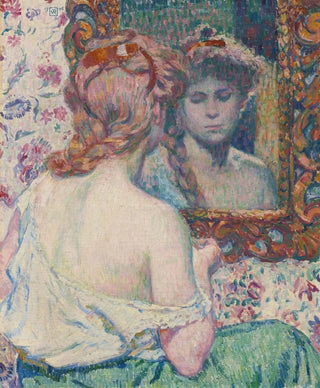Art print | Woman at the mirror - Theo van Rysselberghe


View from behind

Frame (optional)
In the fascinating universe of art, some works transcend time and space, captivating viewers with their beauty and depth. "Femme au miroir" by Theo van Rysselberghe is one of these timeless creations. This piece, created at the end of the 19th century, embodies the very essence of the Neo-Impressionist movement, while offering an intimate reflection on femininity and contemplation. The artwork, with its delicate nuances and carefully orchestrated composition, invites an exploration of the emotions and thoughts of its subject. The woman depicted, immersed in a moment of reflection, appears both distant and accessible, creating a subtle connection between the artwork and the viewer.
Style and uniqueness of the work
Van Rysselberghe's style in "Femme au miroir" is a perfect example of the application of Neo-Impressionist techniques. The color palette, delicate and nuanced, plays a central role in creating an atmosphere filled with serenity. The brushstrokes, both precise and fluid, bring life to the texture of the skin and the softness of the drapery. This artwork does not merely depict a woman; it captures the essence of her introspection. The subtly modulated light highlights the contours of the face and the reflections in the mirror, creating a visual dialogue between the interior and exterior. This play of light and shadow, characteristic of Van Rysselberghe's work, reinforces the idea that beauty resides as much in the surface as in the depth of thoughts.
The artist and his influence
Theo van Rysselberghe, an emblematic figure of Neo-Impressionism, knew how to mark his era with an innovative approach to painting. Born in Belgium, he was influenced by the masters of the Impressionist movement, while developing his own distinctive style. His pointillism technique, which involves applying juxtaposed color strokes, allows for the creation of a unique luminosity and chromatic vibration that animate his works. Van Rysselberghe also played a crucial role in promoting modern art in Belgium, contributing to the emergence of many contemporary artists. His ability to

Matte finish

View from behind

Frame (optional)
In the fascinating universe of art, some works transcend time and space, captivating viewers with their beauty and depth. "Femme au miroir" by Theo van Rysselberghe is one of these timeless creations. This piece, created at the end of the 19th century, embodies the very essence of the Neo-Impressionist movement, while offering an intimate reflection on femininity and contemplation. The artwork, with its delicate nuances and carefully orchestrated composition, invites an exploration of the emotions and thoughts of its subject. The woman depicted, immersed in a moment of reflection, appears both distant and accessible, creating a subtle connection between the artwork and the viewer.
Style and uniqueness of the work
Van Rysselberghe's style in "Femme au miroir" is a perfect example of the application of Neo-Impressionist techniques. The color palette, delicate and nuanced, plays a central role in creating an atmosphere filled with serenity. The brushstrokes, both precise and fluid, bring life to the texture of the skin and the softness of the drapery. This artwork does not merely depict a woman; it captures the essence of her introspection. The subtly modulated light highlights the contours of the face and the reflections in the mirror, creating a visual dialogue between the interior and exterior. This play of light and shadow, characteristic of Van Rysselberghe's work, reinforces the idea that beauty resides as much in the surface as in the depth of thoughts.
The artist and his influence
Theo van Rysselberghe, an emblematic figure of Neo-Impressionism, knew how to mark his era with an innovative approach to painting. Born in Belgium, he was influenced by the masters of the Impressionist movement, while developing his own distinctive style. His pointillism technique, which involves applying juxtaposed color strokes, allows for the creation of a unique luminosity and chromatic vibration that animate his works. Van Rysselberghe also played a crucial role in promoting modern art in Belgium, contributing to the emergence of many contemporary artists. His ability to






